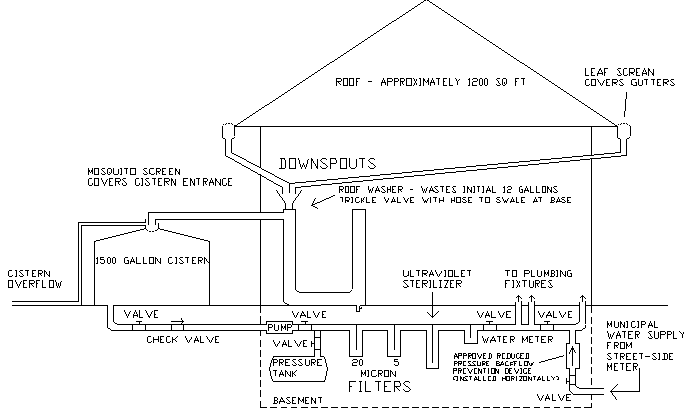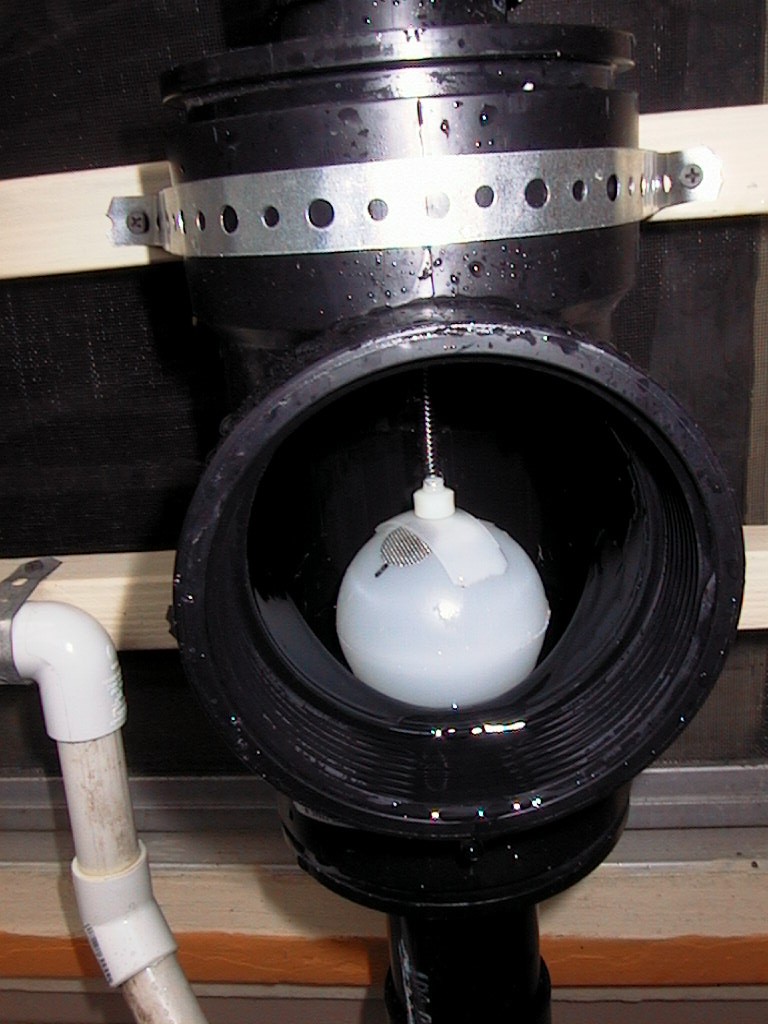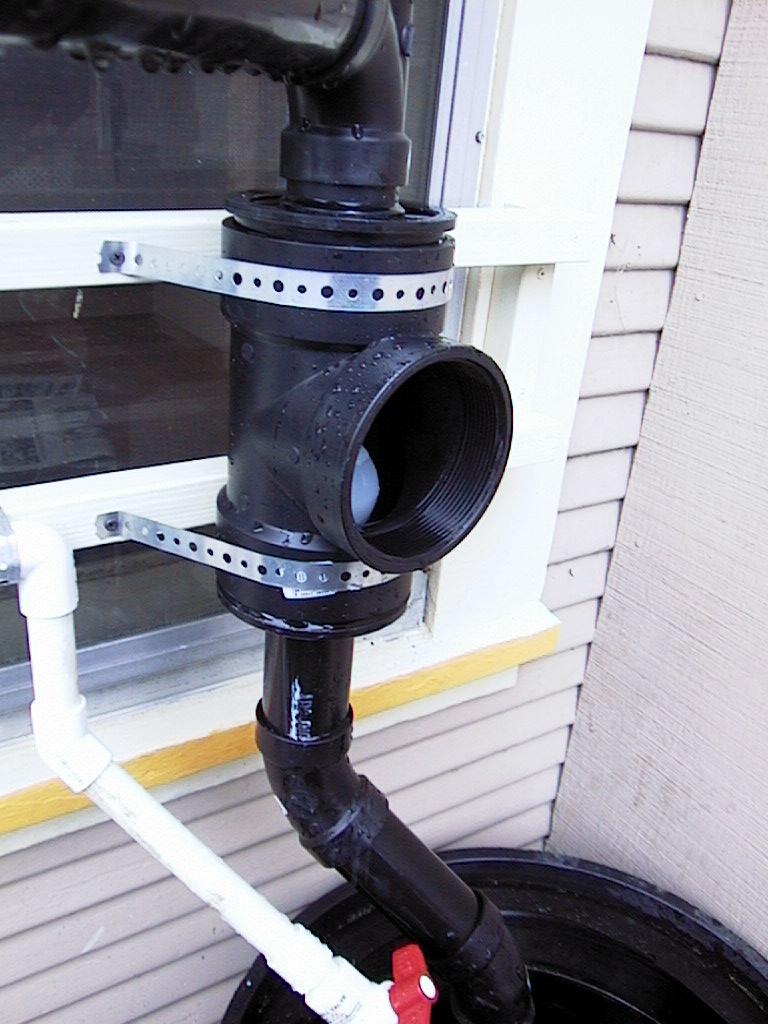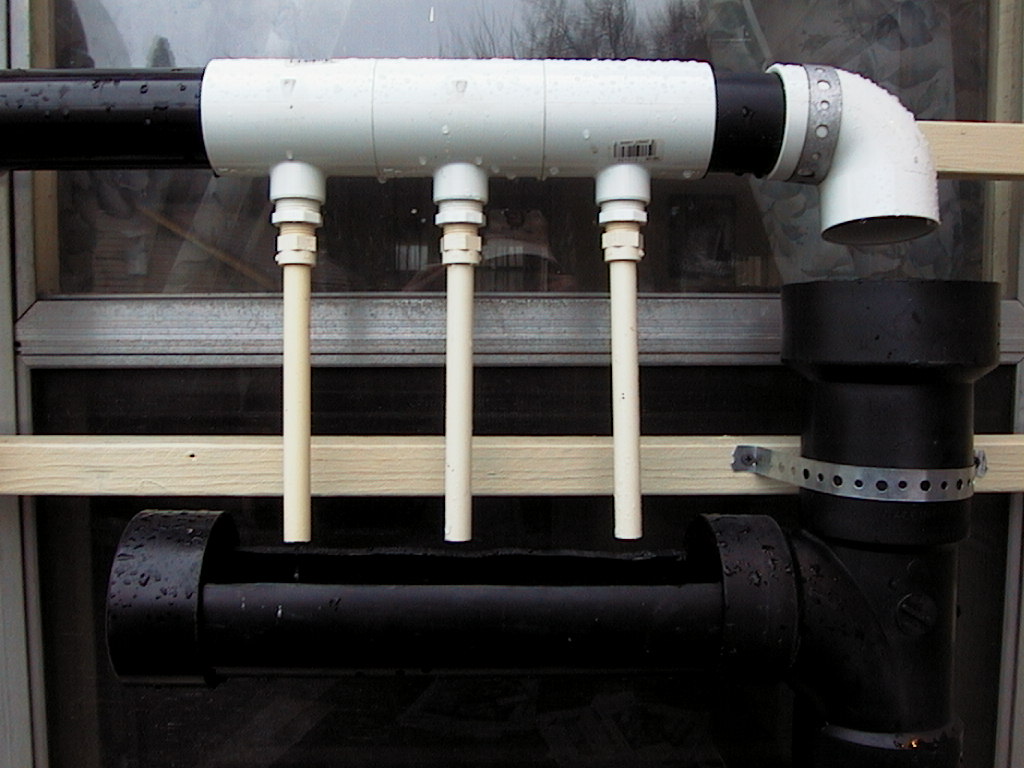Rainwater Harvesting and Purification System
 In January 1996 we installed a rainwater catchment system to capture
Oregon's abundant rainfall. Portland receives between 3 and 4 feet of rainfall
annually. During a gentle rain a typical Oregon downspout sheds several gallons
per minute. Our twelve hundred square foot roof captures on average 3600 cubic
feet (27,000 gallons) of water per year.
In January 1996 we installed a rainwater catchment system to capture
Oregon's abundant rainfall. Portland receives between 3 and 4 feet of rainfall
annually. During a gentle rain a typical Oregon downspout sheds several gallons
per minute. Our twelve hundred square foot roof captures on average 3600 cubic
feet (27,000 gallons) of water per year.
In 1998 we received approval from the city of Portland to use this water for
all household use. This system, which cost less than $1,500, consists of the
following components:
- A 1500 gallon plastic cistern, approximate cost: $500. Our tank was made
by Snyder
Industries. Contact local agriculture or farm stores for best prices. Or
check yellow page listings for tanks. Here is a link to an
Oregon dealer.
- A 1/2 horsepower shallow-well pump to pressurize the water to between 20
and 30 psi (pressure is adjustable), approximate cost: $250. I utilized a
Jacuzzi brand pump.
- Plastic (outdoor PVC and indoor CPVC) piping to connect to the household
cold water system.
- Two particulate filters in series, rated at 20 and 5 micron particle size,
approximate cost: $20 each; replaceable filter cartridges cost $3-5 each.
- An ultraviolet light sterilizer capable of sterilizing water at 10 gallons
per minute. This appliance was recently approved for use in Oregon. I used the
PURA (1-800-292-PURA, Valencia, California) model UV20-1, cost approximately
$350. Uses about 40 watts. Fluorescent ultraviolet light rated at 9600 hours,
about one year of continuous use. Replacement cost of fluorescent tube: about
$80.
- Screen covering the cistern to prevent entry of mosquitoes and to catch
any large particles that make it past the gutter screening.
- A roof-washer which wastes the first 7.5 gallons of captured water which
has "washed" the roof. Once the roof washer has filled, the rest of the water
flows to the cistern. See below for details.
- A 20 gallon water butyl rubber diaphragm pressure storage tank,
approximate cost: $150.
- A reduced pressure backflow prevention device. This was required by the
city to prevent flow of rainwater into the public system. Cost: $120. This
would not be necessary if we used rainwater exclusively. However, Oregon has
very dry summers and our cistern is exhausted by July. We currently depend on
city water during the summer. The city requires annual inspection of these
devices, costing about $30. (See photo below.)
- A (optional) water meter to measure rainwater output, approximate cost:
$45.

 Maintenance consists of keeping gutters and cistern screen
clean. Filters and ultra-violet lamp will need periodic replacement. The tank is
thoroughly cleaned annually in the summer when it empties. Backflow prevention
device requires annual inspection. Public health authorities recommend periodic
testing of water for fecal coliform bacteria, as for any private water system.
Several recent tests showed none. The inside components of our system, pictured
here, take up about 6 square feet of floor space.
Maintenance consists of keeping gutters and cistern screen
clean. Filters and ultra-violet lamp will need periodic replacement. The tank is
thoroughly cleaned annually in the summer when it empties. Backflow prevention
device requires annual inspection. Public health authorities recommend periodic
testing of water for fecal coliform bacteria, as for any private water system.
Several recent tests showed none. The inside components of our system, pictured
here, take up about 6 square feet of floor space.
At the current time we continue to use the public water supply only for
summertime water and occasional drinking and cooking. In fact, during the rainy
season, which lasts from about September to June, our only connection to the
public utility is one faucet at the kitchen sink which uses less than one gallon
per day, which got us into hot water with the city
water bureau.
In my research on rainwater catchment systems the best single reference I
have come across for detailed design guidelines is the Texas Water Development
Board's Texas
Guide to Rainwater Harvesting.
 Roofwashers. A simple prototype is shown in
the TG. It consists of a length of pipe for storage of the initial flush of
water with a trickle valve (hose bib just slightly opened) and clean out valve
at the bottom. Only when the this pipe fills is water then allowed to continue
into the cistern. It's very simple, no moving parts. The only thing I would
change is to have a narrow section or trap configuration at the top to reduce
mixing of the flush water with the still arriving (clean) water. Yet another
method to aid this is to add a lightweight (like styrofoam) ball that would seal
the intake when the roof washer fills. This simple design is very inexpensive,
easy to drain or clean manually, and works very well. The TG suggests one gallon
of washer capacity for each 100 square feet of roof. So make your roof washer
pipe length long enough. For our model we used 20 feet of 3" ABS. We made it in
the shape of a giant U to get this length. Remember, volume equals length times
area. Area equals pi times radius squared (in our case 3 inches internal
diameter, or .25 foot) and one cubic foot equals 7.5 gallons. To avoid long
lengths of roofwasher pipe, it makes sense to use larger diameters. Portland's
chief residential plumbing inspector commented that our use of ABS didn't
conform to code as plastic may eventually decay in sunlight. Therefore, you
should use copper, iron, or other sunlight-resistant materials to be completely
correct. Or simply paint any plastic parts to protect them from the effects of
sun light.
Roofwashers. A simple prototype is shown in
the TG. It consists of a length of pipe for storage of the initial flush of
water with a trickle valve (hose bib just slightly opened) and clean out valve
at the bottom. Only when the this pipe fills is water then allowed to continue
into the cistern. It's very simple, no moving parts. The only thing I would
change is to have a narrow section or trap configuration at the top to reduce
mixing of the flush water with the still arriving (clean) water. Yet another
method to aid this is to add a lightweight (like styrofoam) ball that would seal
the intake when the roof washer fills. This simple design is very inexpensive,
easy to drain or clean manually, and works very well. The TG suggests one gallon
of washer capacity for each 100 square feet of roof. So make your roof washer
pipe length long enough. For our model we used 20 feet of 3" ABS. We made it in
the shape of a giant U to get this length. Remember, volume equals length times
area. Area equals pi times radius squared (in our case 3 inches internal
diameter, or .25 foot) and one cubic foot equals 7.5 gallons. To avoid long
lengths of roofwasher pipe, it makes sense to use larger diameters. Portland's
chief residential plumbing inspector commented that our use of ABS didn't
conform to code as plastic may eventually decay in sunlight. Therefore, you
should use copper, iron, or other sunlight-resistant materials to be completely
correct. Or simply paint any plastic parts to protect them from the effects of
sun light.
Rainbarrels. A rainwater harvesting system can be as simple
as a barrel connected to a downspout. Check the Rainbarrel Tutorial
for tips on how to put together a system for as little as $15-20. One of our
neighbors has connected his rainbarrel to his basement washing machine and gets
virtually all his laundry water from this super-soft source for a miniscule
investment.
One notable advantage of rainwater is its softness. Rainfall in the Portland
area contains about 5 mg/liter of dissolved minerals. Compare this with some
hard groundwater which exceeds 500 mg/liter. Portland city water, which has an
exceptionally pure source, is rated at 12 mg/liter.
According to two officials in Alaska and Hawaii with whom I have
communicated, there is a long established tradition of rainwater collection in
some parts of their states. According to Sourcebook
Harvested Rainwater, in some areas of the Caribbean, new houses are required
to have rainwater capture systems. Hawaii apparently is currently developing (or
has already developed) guidelines. In Oregon, there is no regulation of water
quality for individual residences -- this is left up to the homeowner. The only
regulations I have come across relating to rainwater harvesting are from Ohio,
whose Department of Health Administrative Code regulates private water
systems. Note, in particular, Rules 3701-28-09 Continuous disinfection and
3701-28-13 Construction and surface design of cisterns, hauled water storage
tanks, and roof washers.

A great resource for rainwater harvesting information is Warwick (Coventry,
United Kingdom) University's Development Technology Unit Roofwater Harvesting
Programme.
Update Summer 2002 -- A different style of roof washer. This summer we
installed a commercially
available roof washer that uses a programmable valve to divert a rain's
first flow away from the cistern. A purported advantage is the absence of
standing water that can stagnate and potentially contaminate the cistern water.
(This could happen, for example, if the trickle valve on the conventional device
were to clog or it were left closed.) Below are two photos of the system with
this new device. The first photo shows the roof washer mounted on a window frame
near the cistern. Rainwater, which enters from the two downspouts above, can be
observed from inside the dwelling. The first flush is diverted downwards into a
holding barrel. An overflow hose from the top of the cistern also empties into
this barrel. Post-flush water enters the cistern via the roof washer's side port
through a screened cistern entry hole. The barrel overflow is directed to a
swale in the middle of our back yard.


Update January 2004 -- A simplified, American-made, roof washer and
rainwater sculpture. I never was able to get the SafeRain roof washer to
function properly in Oregon's often drizzly weather. Either the roof washer
diversion valve would not properly close, thus diverting all the rainwater into
the overflow, or it would not open after the rainfall event ended, retaining
dirty water in the device. I attempted numerous times to adjust it, all to no
avail. Unfortunately, for this reason, I can not recommend this device. The last
straw came during recent freezing weather when the device froze with water in
it, rendering it non-functional. Therefore, recently, I installed a newer style of first-flush
device. This device is considerably less expensive (approximately $66 versus
$140 at currency exchange rates 22 Jan 2004, including shipping) for North
Americans, since it is locally made and uses standard pipe fittings. The
first-flush valve kit consists of a hollow ball (see middle two photos below)
which, when filled by the initial flow of water, seats itself onto a rubber
gasket. This closes the overflow pipe and subsequent rainwater is then diverted
to the cistern. After the rain stops the ball empties and the diversion valve
returns to the open position. I will post a review of how well this device
performs at the end of this rainy season. At this time it already seems to be
functioning properly.




At the same time I installed this roof washer I also installed a more
elaborate piping configuration (see photo, above, left) leading from the
downspouts to the cistern that is intended to act as a water sculpture. Viewable
from our dining room window, it will display ten areas of flowing water,
depending on the time in a rainwater event and the rainwater flow. During a
typical Oregon drizzle, only the left most vertical pipe (see photo, above
right) carries water. During a downpour all three pipes will be filled to
capacity and additional flow will emerge from the 2" elbow.
Rainwater Harvesting and Purification System / Feedback
welcome / revised February 05, 2004
 In January 1996 we installed a rainwater catchment system to capture
Oregon's abundant rainfall. Portland receives between 3 and 4 feet of rainfall
annually. During a gentle rain a typical Oregon downspout sheds several gallons
per minute. Our twelve hundred square foot roof captures on average 3600 cubic
feet (27,000 gallons) of water per year.
In January 1996 we installed a rainwater catchment system to capture
Oregon's abundant rainfall. Portland receives between 3 and 4 feet of rainfall
annually. During a gentle rain a typical Oregon downspout sheds several gallons
per minute. Our twelve hundred square foot roof captures on average 3600 cubic
feet (27,000 gallons) of water per year. 
 Maintenance consists of keeping gutters and cistern screen
clean. Filters and ultra-violet lamp will need periodic replacement. The tank is
thoroughly cleaned annually in the summer when it empties. Backflow prevention
device requires annual inspection. Public health authorities recommend periodic
testing of water for fecal coliform bacteria, as for any private water system.
Several recent tests showed none. The inside components of our system, pictured
here, take up about 6 square feet of floor space.
Maintenance consists of keeping gutters and cistern screen
clean. Filters and ultra-violet lamp will need periodic replacement. The tank is
thoroughly cleaned annually in the summer when it empties. Backflow prevention
device requires annual inspection. Public health authorities recommend periodic
testing of water for fecal coliform bacteria, as for any private water system.
Several recent tests showed none. The inside components of our system, pictured
here, take up about 6 square feet of floor space. Roofwashers. A simple prototype is shown in
the TG. It consists of a length of pipe for storage of the initial flush of
water with a trickle valve (hose bib just slightly opened) and clean out valve
at the bottom. Only when the this pipe fills is water then allowed to continue
into the cistern. It's very simple, no moving parts. The only thing I would
change is to have a narrow section or trap configuration at the top to reduce
mixing of the flush water with the still arriving (clean) water. Yet another
method to aid this is to add a lightweight (like styrofoam) ball that would seal
the intake when the roof washer fills. This simple design is very inexpensive,
easy to drain or clean manually, and works very well. The TG suggests one gallon
of washer capacity for each 100 square feet of roof. So make your roof washer
pipe length long enough. For our model we used 20 feet of 3" ABS. We made it in
the shape of a giant U to get this length. Remember, volume equals length times
area. Area equals pi times radius squared (in our case 3 inches internal
diameter, or .25 foot) and one cubic foot equals 7.5 gallons. To avoid long
lengths of roofwasher pipe, it makes sense to use larger diameters. Portland's
chief residential plumbing inspector commented that our use of ABS didn't
conform to code as plastic may eventually decay in sunlight. Therefore, you
should use copper, iron, or other sunlight-resistant materials to be completely
correct. Or simply paint any plastic parts to protect them from the effects of
sun light.
Roofwashers. A simple prototype is shown in
the TG. It consists of a length of pipe for storage of the initial flush of
water with a trickle valve (hose bib just slightly opened) and clean out valve
at the bottom. Only when the this pipe fills is water then allowed to continue
into the cistern. It's very simple, no moving parts. The only thing I would
change is to have a narrow section or trap configuration at the top to reduce
mixing of the flush water with the still arriving (clean) water. Yet another
method to aid this is to add a lightweight (like styrofoam) ball that would seal
the intake when the roof washer fills. This simple design is very inexpensive,
easy to drain or clean manually, and works very well. The TG suggests one gallon
of washer capacity for each 100 square feet of roof. So make your roof washer
pipe length long enough. For our model we used 20 feet of 3" ABS. We made it in
the shape of a giant U to get this length. Remember, volume equals length times
area. Area equals pi times radius squared (in our case 3 inches internal
diameter, or .25 foot) and one cubic foot equals 7.5 gallons. To avoid long
lengths of roofwasher pipe, it makes sense to use larger diameters. Portland's
chief residential plumbing inspector commented that our use of ABS didn't
conform to code as plastic may eventually decay in sunlight. Therefore, you
should use copper, iron, or other sunlight-resistant materials to be completely
correct. Or simply paint any plastic parts to protect them from the effects of
sun light.





